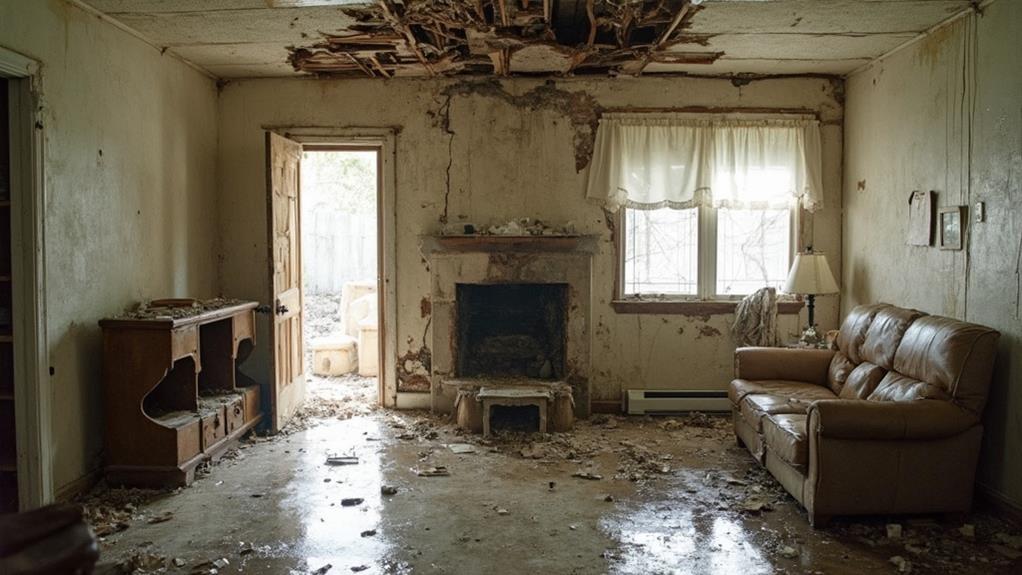Standing water poses severe threats to a building's structural integrity. It can weaken foundations, causing cracks and compromising stability. Prolonged moisture exposure leads to wood rot, decay, and the growth of harmful mold and mildew. Electrical systems may be damaged, creating fire hazards. Insulation effectiveness is reduced, impacting energy efficiency. Flooring and walls can warp, swell, or crumble due to water absorption. Swift water removal and thorough drying are crucial to minimize damage. Professional inspection and remediation are often necessary to address these issues. Understanding these risks is essential for protecting your property and ensuring occupant safety.
Foundation Weakening and Cracking
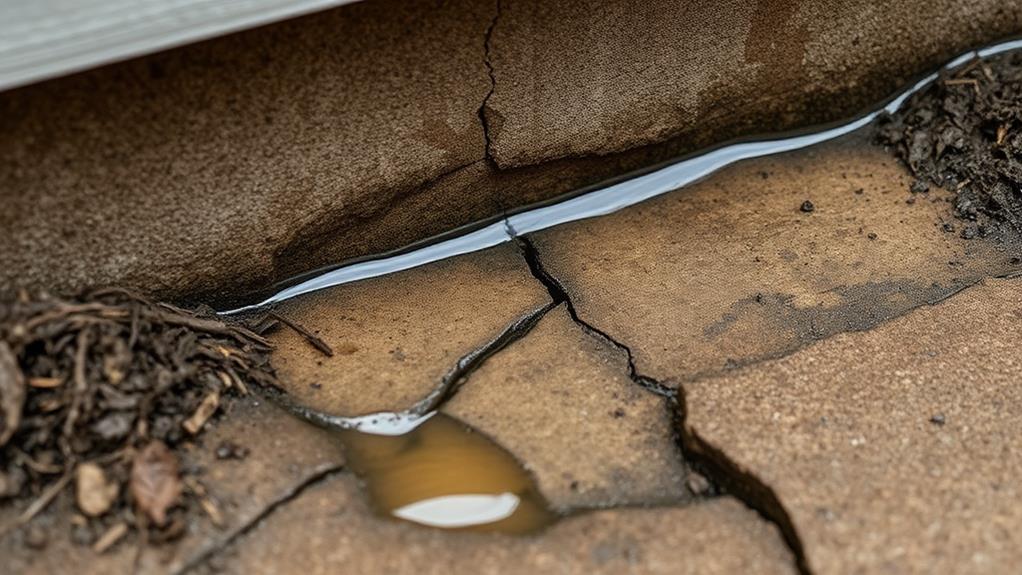
When water accumulates around a building's foundation, it can lead to significant structural damage over time. The constant presence of standing water can erode soil, creating voids beneath the foundation. This erosion compromises the structural integrity of the building, potentially causing settlement and uneven distribution of weight.
As water seeps into the foundation material, it can weaken concrete and mortar, leading to cracks and fissures. These openings allow more water to penetrate, exacerbating the problem. In areas with freeze-thaw cycles, water trapped in these cracks expands when frozen, further widening the gaps and accelerating deterioration.
Standing water also increases hydrostatic pressure against foundation walls, potentially causing them to bow or crack. This pressure can force water through even the tiniest openings, leading to basement flooding and moisture issues. Additionally, prolonged exposure to moisture can corrode steel reinforcements within concrete foundations, compromising their strength.
To prevent these issues, proper drainage systems, including gutters, downspouts, and grading, are essential. Regular inspections and prompt repair of any cracks or visible damage can help maintain the foundation's integrity and prevent costly structural repairs in the future.
Wood Rot and Decay
Standing water not only affects a building's foundation but also poses significant risks to wooden structural elements. When wood is exposed to prolonged moisture, it becomes an ideal environment for fungi and bacteria to thrive, leading to wood rot and decay. This process can severely compromise the integrity of wooden components, including support beams, floor joists, and wall studs.
Wood rot typically manifests in two forms: dry rot and wet rot. Dry rot, caused by specific fungi, can spread rapidly through wood and even across masonry, potentially affecting large areas of a structure. Wet rot, while generally more localized, can still cause significant damage to load-bearing elements. Both types of rot weaken the wood's cellular structure, reducing its strength and load-carrying capacity.
The deterioration of wooden components can lead to sagging floors, warped walls, and in severe cases, structural collapse. Early detection is crucial, as wood rot can progress unseen within walls or beneath flooring. Regular inspections, proper ventilation, and prompt addressing of water ingress are essential preventive measures. If wood rot is discovered, affected areas must be thoroughly dried, treated, and often replaced to maintain the building's structural integrity.
Mold and Mildew Growth
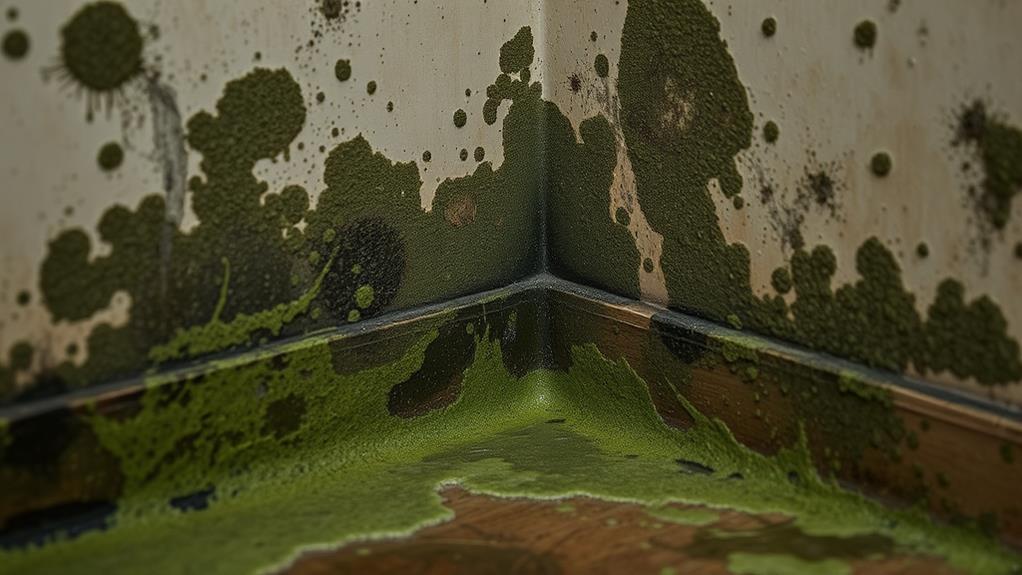
Nearly all cases of prolonged standing water lead to mold and mildew growth, posing significant health risks and structural concerns. These fungi thrive in damp, humid environments and can begin to proliferate within 24 to 48 hours of water exposure. As they spread, mold and mildew release spores that can cause respiratory issues, allergic reactions, and other health problems for building occupants.
From a structural perspective, mold and mildew can cause extensive damage to various building materials. They feed on organic substances, including wood, drywall, carpeting, and insulation, gradually breaking down these materials and compromising their integrity. This deterioration can weaken load-bearing structures, leading to potential collapses or failures over time.
Additionally, mold and mildew growth can create unsightly stains and unpleasant odors, reducing property value and making spaces uninhabitable. Remediation efforts often require professional intervention, involving the removal and replacement of affected materials, which can be costly and time-consuming. To prevent mold and mildew growth, it is crucial to address standing water issues promptly and maintain proper ventilation and humidity control in affected areas.
Electrical System Hazards
Although often overlooked, electrical system hazards pose a significant threat in areas affected by standing water. When water comes into contact with electrical systems, it can create dangerous conditions that put both property and lives at risk. Standing water can compromise the integrity of electrical wiring, outlets, and appliances, potentially leading to short circuits, electrocution, or fires.
Water-damaged electrical components may corrode over time, further increasing the risk of system failure or electrical fires. Even after visible water has receded, moisture can remain trapped within walls, floors, and electrical conduits, continuing to pose a threat. It's crucial to have a qualified electrician inspect and assess the entire electrical system before attempting to restore power to a water-damaged structure.
Safety measures such as shutting off the main power supply, unplugging all electrical devices, and avoiding contact with standing water near electrical sources are essential. In severe cases, extensive rewiring or replacement of electrical systems may be necessary to ensure the safety and proper functioning of the property. Proper assessment and remediation of electrical hazards are vital steps in the recovery process following water damage incidents.
Compromised Insulation Effectiveness
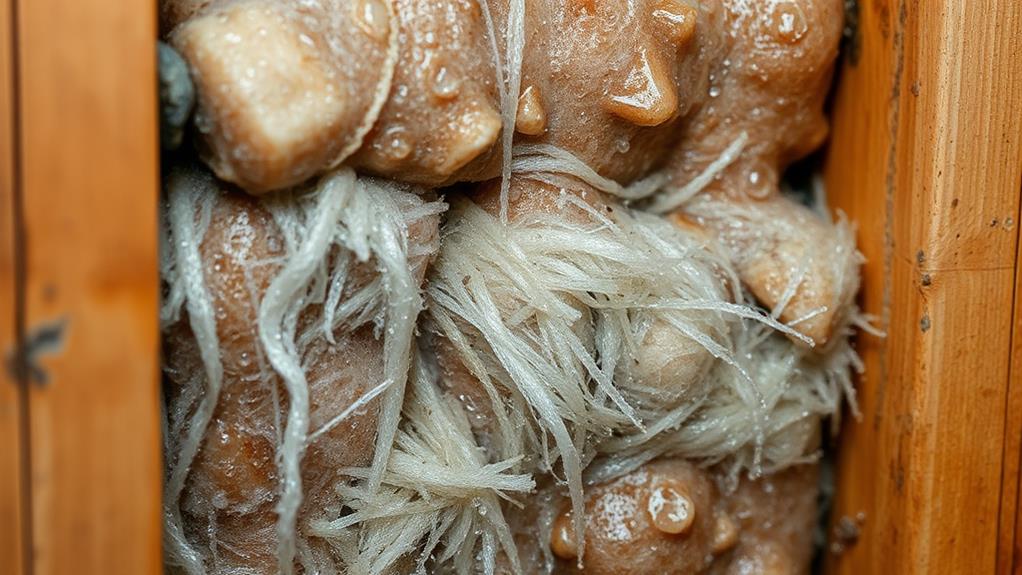
When exposed to standing water, insulation materials in walls, floors, and attics can suffer significant damage, leading to compromised effectiveness. Water absorption causes insulation to lose its thermal resistance properties, reducing its ability to regulate indoor temperatures efficiently. Fiberglass insulation, one of the most common types, can become compressed and lose its air-trapping capabilities when saturated. This compression not only diminishes its insulating power but also creates gaps that allow heat transfer.
Cellulose insulation, made from recycled paper products, is particularly vulnerable to water damage. It can absorb moisture quickly, leading to mold growth and deterioration. Foam insulations, while more water-resistant, can still be affected by prolonged exposure to standing water, potentially causing warping or separation from surfaces. The compromised insulation effectiveness results in increased energy costs as heating and cooling systems work harder to maintain desired temperatures. Additionally, moisture-laden insulation creates an ideal environment for mold and mildew growth, posing health risks to occupants. To mitigate these issues, it's crucial to address standing water problems promptly and replace damaged insulation to restore the structure's energy efficiency and maintain a healthy indoor environment.
Warped Flooring and Walls
As a consequence of standing water, flooring and walls can suffer significant warping, leading to structural instability and aesthetic damage. This occurs when materials like wood, laminate, or drywall absorb excess moisture, causing them to swell, buckle, or become misshapen. Hardwood floors are particularly susceptible, as the planks may cup or crown, creating an uneven surface and potentially separating from the subfloor.
In walls, prolonged exposure to standing water can cause drywall to soften, sag, or crumble. The wooden studs behind the drywall may also warp or rot, compromising the structural integrity of the entire wall. Plaster walls can develop cracks or begin to separate from their lath backing. Additionally, warped walls can lead to misaligned doors and windows, making them difficult to open or close properly.
The severity of warping depends on factors such as the duration of water exposure, the type of materials affected, and the ambient temperature and humidity. Swift water removal and thorough drying are crucial to minimizing damage. In severe cases, affected flooring and wall sections may need to be entirely replaced to ensure the building's safety and structural soundness.
Soil Erosion Around Structures
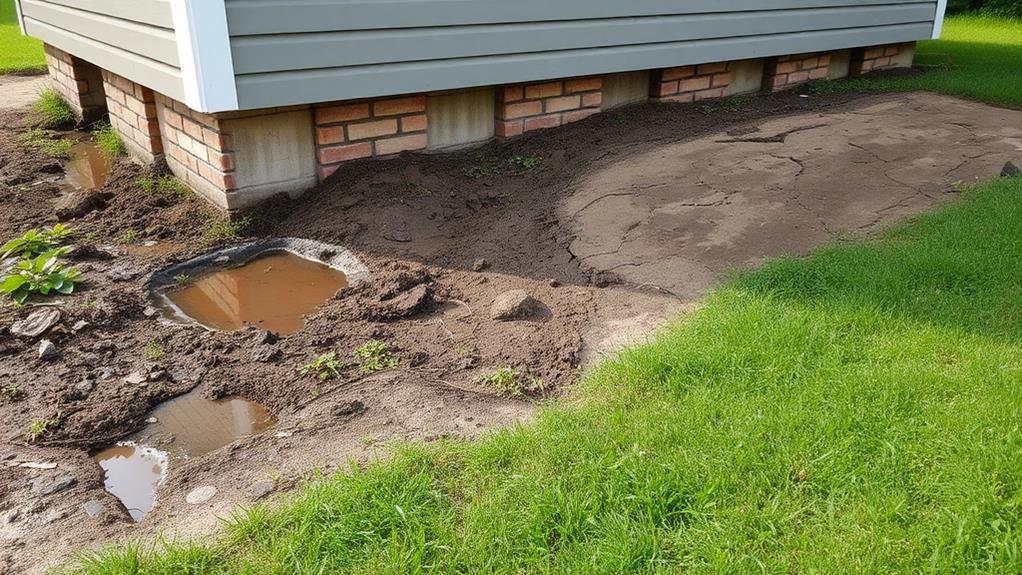
Standing water not only affects the interior of structures but also poses significant risks to their foundations and surrounding soil. Prolonged exposure to standing water can lead to soil erosion, which undermines the stability of buildings and other structures. As water saturates the ground, it weakens the soil's cohesive properties, causing it to shift and wash away.
This erosion process can create voids beneath foundations, driveways, and walkways, potentially leading to settling, cracking, or even collapse. The problem is exacerbated in areas with expansive clay soils, which swell when wet and shrink when dry, causing additional stress on foundations. Moreover, standing water can alter drainage patterns around structures, redirecting water flow and potentially causing further erosion in unexpected areas.
To mitigate these risks, proper grading and drainage systems are essential. Regular inspections of the property, especially after heavy rainfall or flooding events, can help identify early signs of soil erosion. Addressing drainage issues promptly, maintaining gutters and downspouts, and implementing erosion control measures such as retaining walls or vegetation can significantly reduce the risk of structural damage due to soil erosion caused by standing water.
Pest Infestations and Damage
Numerous pest species thrive in the moist environments created by standing water, leading to infestations that can cause significant structural damage. Termites, carpenter ants, and wood-boring beetles are particularly problematic, as they can compromise the integrity of wooden structures. These pests are attracted to damp wood, which becomes softer and easier to penetrate.
Mosquitoes also breed in standing water, posing health risks to occupants and potentially damaging wooden surfaces through their feeding habits. Rodents, such as rats and mice, are drawn to moist areas and can gnaw through various building materials, including electrical wiring, insulation, and wooden structures.
Fungi and mold thrive in damp conditions, leading to wood rot and decay. This not only weakens structural elements but can also cause health issues for building occupants. Additionally, cockroaches and silverfish are attracted to humid environments, potentially causing damage to paper products, fabrics, and other materials.
To mitigate these risks, it's crucial to eliminate standing water sources, improve drainage around structures, and maintain proper ventilation. Regular inspections and prompt treatment of any infestations are essential to prevent long-term structural damage and ensure building safety.
Long-Term Structural Instability
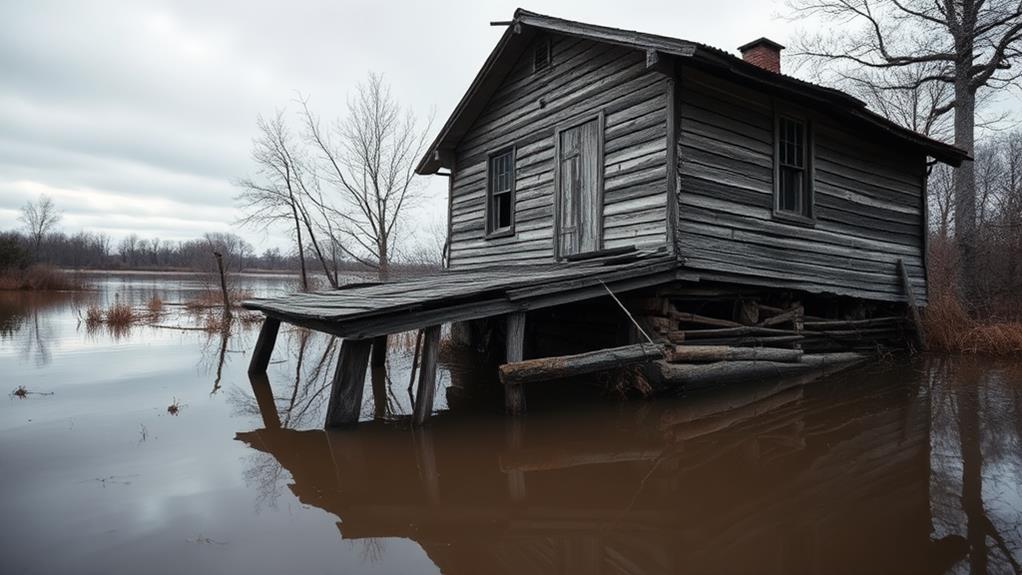
Prolonged exposure to standing water can lead to severe long-term structural instability in buildings. As water seeps into the foundation and building materials, it weakens the structural integrity of the entire edifice. This deterioration often occurs gradually, making it difficult to detect until significant damage has already taken place.
The most vulnerable components are load-bearing elements such as support beams, floor joists, and wall studs. Water saturation causes these wooden structures to warp, rot, and lose their strength, potentially leading to partial or complete collapse. Concrete foundations are also at risk, as water can erode the material and cause cracks to form or expand. These cracks allow for further water infiltration, exacerbating the problem.
Metal components, including steel reinforcements and fasteners, are susceptible to corrosion when exposed to moisture for extended periods. This corrosion weakens critical connections throughout the building, compromising its overall stability. Additionally, the soil beneath the structure may become oversaturated, leading to settling or shifting of the foundation. This movement can cause walls to crack, doors and windows to misalign, and floors to become uneven, further compromising the building's structural integrity.
Frequently Asked Questions
How Quickly Can Standing Water Cause Structural Damage?
Standing water can cause structural damage within hours to days, depending on various factors. Prolonged exposure increases risk. Wood can warp within 24 hours, while concrete may take days to weeks to show significant damage.
Can Standing Water Affect My Home's Resale Value?
Persistent pooling propensity potentially plummets property prices. Standing water can significantly impact your home's resale value by causing structural damage, mold growth, and foundation issues. Prospective buyers may be deterred, leading to decreased market appeal and lower offers.
Are There Any Specific Insurance Considerations for Standing Water Damage?
Homeowners insurance typically covers sudden water damage but may exclude long-term standing water issues. It's crucial to review your policy, consider additional flood insurance, and promptly address standing water to avoid potential claim denials or coverage gaps.
What Preventive Measures Can I Take Against Standing Water Accumulation?
Picture a tranquil oasis, free from unwanted puddles. To achieve this, ensure proper grading, install effective drainage systems, maintain gutters and downspouts, apply waterproof coatings, and regularly inspect your property for potential water accumulation points.
How Do I Detect Hidden Standing Water Issues in My Property?
To detect hidden standing water issues, conduct regular inspections of basements, crawl spaces, and attics. Look for signs of moisture, musty odors, or water stains. Use moisture meters and infrared cameras for more thorough assessments of potential problem areas.
Conclusion
In light of the potential consequences outlined, it becomes apparent that standing water poses significant risks to structural integrity. Swift action is paramount to mitigate these challenges. By addressing water-related issues promptly, property owners can safeguard their investments and ensure long-term stability. Vigilance and proactive measures are key in preserving the health and longevity of buildings. Ultimately, a dry foundation is the cornerstone of a sound structure and a secure living environment.
